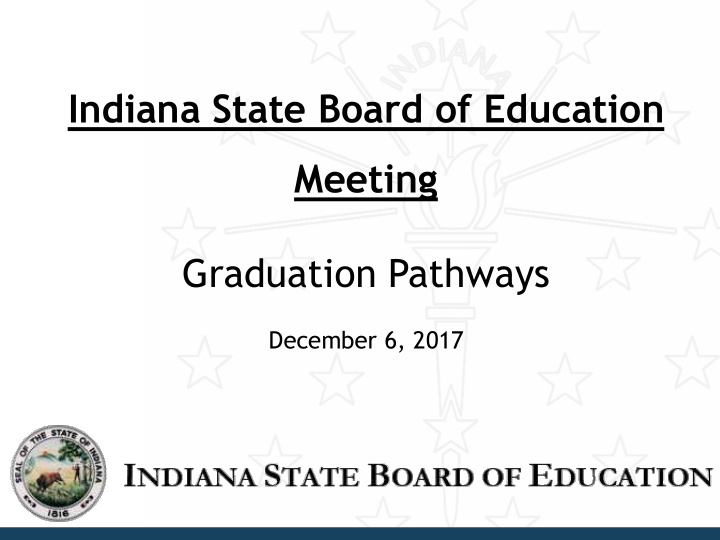



Indiana State Board of Education Meeting Graduation Pathways December 6, 2017
Statutory Authority IC 20-32-4-1.5 Pathway requirements (a) This section applies after June 30, 2018. (b) Except as provided in sections 4, 5, 6, 7, 8, 9, and 10 of this chapter, each student shall: (1) demonstrate college or career readiness through a pathway established by the state board, in consultation with the department of workforce development and the commission for higher education; (2) meet the Core 40 course and credit requirements adopted by the state board under IC 20-30-10; and (3) meet any additional requirements established by the governing body; to be eligible to graduate. (c) The state board shall establish graduation pathway requirements under subsection (b)(1) in consultation with the department of workforce development and the commission for higher education. A graduation pathway requirement may include the following options approved by the state board: (1) End of course assessments measuring academic standards in subjects determined by the state board. (2) International baccalaureate exams. (3) Nationally recognized college entrance assessments. (4) Advanced placement exams. (5) Assessments necessary to receive college credit for dual credit courses. (6) Industry recognized certificates. (7) The Armed Services Vocational Aptitude Battery. (8) Any other pathway approved by the state board. (d) If the state board establishes a nationally recognized college entrance exam as a graduation pathway requirement, the nationally recognized college entrance exam must be offered to a student at the school in which the student is enrolled and during the normal school day.
ECA Remedial Loop Enroll in Take the remedial ECA labs Do not pass ECA
Changing Economy Over 95 percent of jobs created during the recovery have gone to workers with at least some college education, while those with a high school diploma or less are being left behind. The Great Recession decimated low-skill blue-collar and clerical jobs, whereas the recovery added primarily high-skill managerial and professional jobs. Good jobs have shifted toward associate’s degree holders and away from workers with a high school diploma or less. Between 1991 and 2015, Indiana lost 31,000 blue-collar non-BA good jobs, but gained 128,000 skilled-services good jobs for workers without BAs.
Changing Economy cont.
Significant growth in middle-skills jobs
Gaps in talent According to the Department of Workforce Development, over the next ten years, Indiana will have 1 million vacant jobs. Over half of the 1 million projected vacant jobs will require postsecondary attainment. By 2020, between 62-65% of all Hoosier jobs will require postsecondary attainment. Currently, Indiana has an approximately 41% postsecondary attainment, including certificates, associate, bachelor, and graduate degrees.
Gaps in talent cont. meets 60% goal at or above national average below national average
Gaps in talent cont. 47% of jobs have been left unfilled this year due to under-qualified applicants. Employers report that the filling the workforce is the biggest or next biggest challenge facing our businesses. Those employers expecting an increase in workforce size in the next one to two years have even bigger workforce challenges. Two-thirds of our current job vacancies are middle skilled jobs .
Examining postsecondary attainment Of the 72,187 graduates, currently 65% (46,750) go on to any type of postsecondary education or training after high school. 14% (4,687) of those students require remediation in their freshman year – with the majority needing remediation in math.
Examining postsecondary attainment cont. Average GPA for Hoosier freshmen in postsecondary education is a 2.6. General Diploma students earn an average 1.9 GPA Core 40 earn an average 2.2 GPA Honors Diploma earn an average 3.1 GPA
Examining postsecondary attainment cont. Of the 46,750 students that enroll in postsecondary, 34.5% (16,129) of students complete in 4 years; 54.2% (25,339) complete in 6 years
Panel recommendation 10 meetings Over 30 hours of discussion Over 100 collaborators (including 15 national organizations )
Pathway recommendation Graduation Requirements Graduation Pathway Options Meet the statutorily defined diploma credit and curricular requirements. 1. High School Diploma Learn employability skills standards through locally developed programs. 2. Learn and Demonstrate Employability Employability skills are demonstrated by one the following: Skills Project-Based Learning Experience; OR (Students must complete at least Service-Based Learning Experience; OR one of the following.) Work-Based Learning Experience. 3. Postsecondary-Ready Competencies Honors Diploma: Fulfill all requirements of either the Academic or (Students must complete at least Technical Honors diploma; OR one of the following.) ACT: College-ready benchmarks; OR SAT: College-ready benchmarks; OR ASVAB: Earn at least a minimum AFQT score to qualify for placement into one of the branches of the US military; OR State- and Industry-recognized Credential or Certification; OR State-, Federal-, or Industry-recognized Apprenticeship; OR Career-Technical Education Concentrator: Must earn a C average or higher in at least 6 high school credits in a career sequence; OR AP/IB/Dual Credit/Cambridge International courses or CLEP Exams: Must earn a C average or higher in at least three courses; OR Locally created pathway that meets the framework from and earns the approval of the State Board of Education.
Recommend
More recommend